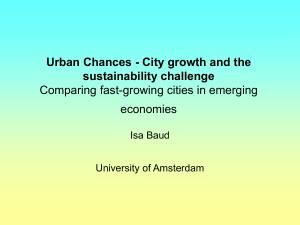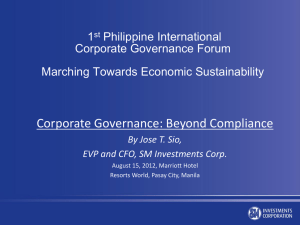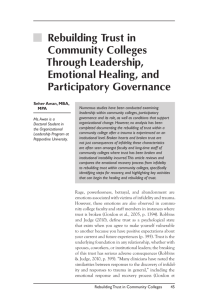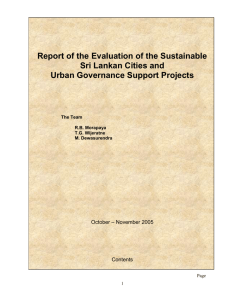the PPT - Environmental Evaluators Network
advertisement
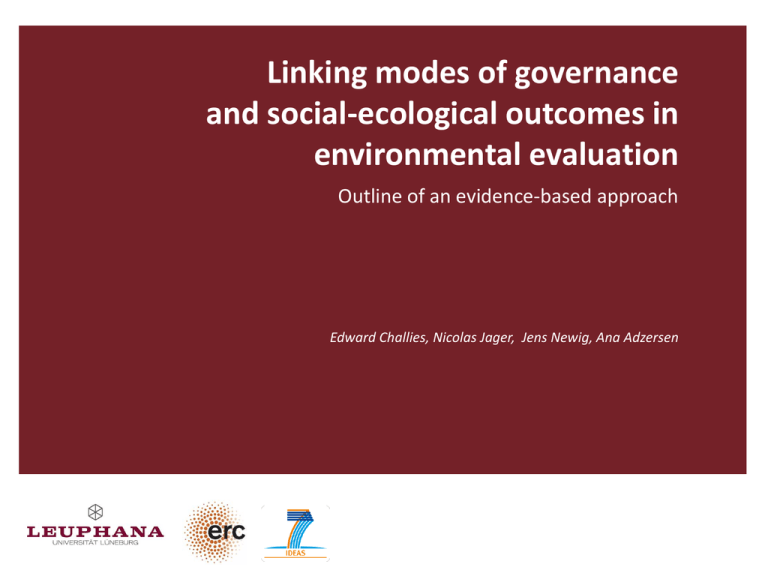
Linking modes of governance and social-ecological outcomes in environmental evaluation Outline of an evidence-based approach Edward Challies, Nicolas Jager, Jens Newig, Ana Adzersen Outline Introduction: Participatory environmental governance Hypotheses: Participation in environmental policy-making Methodology: Meta-analysis Key Contributions 2 Participatory environmental governance Rise of participatory governance, 1970s → State failure, ‘inclusive government’ and ‘good governance’ Instrumental and democratic/emancipatory value of participation Tensions in citizen participation Participatory environmental governance From social side-effects to social-ecological synergies? 3 Hypotheses: Participation in environmental policy-making Hypothesised causal links between: participation and policy effectiveness (implementation, compliance) participation and environmental standards of the output 4 Conceptualising goals of participation instrumental quality of the decision itself incorporation of local knowledge emancipatory quality of implmentation knowledge of stakeholder positions acceptance and identification education and capacity building pre-emptive legal protection balancing of interests building trust transparency and accountability democratic policy formulation addressing conflicts ProceduralJustice-effect 5 Participation policy effectiveness +/Implementation & Compliance (outcomes) - Institutional fit/ compatibility - Knowledge for implementation - Conflict resolution - Representation of diverse interests (incl. veto players) - ‘Win-win’ scenarios - Discursive fairness - Procedural justice - Education of policy addressees - Network creation - Waking sleeping dogs - Demand-institutional misfit 6 Participation environmental standards of output +/Environmental standards of the policy/decision (output) - Representation of environmental actors - Environmentally relevant knowledge - ‘Common good’ - ‘Positive sum game’ solutions - Innovative/creative solutions - Disadvantaging environmental actors - Co-optation of environmental interests - Increased likelihood of veto 7 Example: Procedural justice effects Participatory process Perceived legitimacy & fairness Increased acceptance of the output Improved implementation and compliance 8 Example: Negotiation effects Participatory process Communication & bargaining Optimal allocations & positive sum solutions Higher environmental standards of the output 9 Methodology Meta-analysis - case survey Systematic aggregation of single small-N case study data Precise coding according to theoretically informed scheme transforms qualitative into quantitative data combines richness of case material with scientific rigour of large-N comparative analysis - seldom applied Screening of 2,871 texts for possible cases Population of 572 cases Random sample of 200 cases 10 Conceptual framework for cross-case analysis C ontext P ro b le m s tru c tu re , in s titu tio n a l a n d a c to r c h a ra c te ris tic s P rocess S ocial outcom es F o rm o f p a rtic ip a tio n , fa irn e s s L e a rn in g , tru s t, a c c e p ta n c e S ubstantive output S ubstantive outcom es Im p le m e n ta tio n a n d c o m p lia n c e E nviron m ental im pact C h a n g e s in e n v iro n m e n ta l q u a lity E n viro n m e n ta l s ta n d a rd o f d e c is io n 11 Case-survey analysis – variable coding Description of the case material through semi-quantitative variables DISC FAIR s-q [0..4] (99) Discursive fairness: Degree to which the DMP was executed through a process of fair discourse. Indicators include: all participants must be able to attend, make statements, participate in the discussion, and participate in the decision-making (Webler & Tuler 2000: 569). 0 = DMP was not discursively fair, but highly discriminatory; 2 = DMP afforded participants limited opportunity to engage in fair discourse; 4 = DMP was characterised by fair discourse. Coding done by three coders Resulting data set allows for statistical analysis, QCA, etc. 12 Counterfactual reasoning counterfactual situation with lower intensity of factor 1 current state counterfactual situation with higher intensity of factor 1 Factor 1 ↑ Factor 2 Factor 2 ↑ + causal relationship Factor 1 ↓ Factor 2 ↓ Factor 1 ↑ Factor 2 ↓ - causal relationship Factor 1 ↓ Factor 2 ↑ Factor 1 13 Key contributions Conceptual: Exploring mechanisms by which, and circumstances under which, participation can improve decision/policy-making effectiveness and environmental standard of policies. Policy: Evidence-based insights to support decision/policy-makers to achieve environmental policy goals in a socially and environmentally sustainable way. Aid decision-makers in characterising policy contexts (e.g. environmental issue, stakeholder field, etc.) and selecting suitable modes of participation given specific goals. Methodological: Large N meta-analysis; investigation of causality via hypotheses and counterfactual reasoning. Proposition: Environmental policy evaluation should take stock of the role of public participation in securing both environmental and social outcomes, and not see the latter as mere side-effects. 14 EDGE Project Evaluating the Delivery of Environmental Governance using an Evidence-based Research Design (EDGE) Project team: Prof. Dr Jens Newig, Dr Edward Challies Nicolas Jager M.A. Research Group on Governance, Participation and Sustainability Leuphana University Scharnhorststraße 1 21335 Lüneburg Germany Project timeframe: 2011-2016 http://www.leuphana.de/institute/infu/forschung/governance-nachhaltige-entwicklung.html 15 References Bulkeley, H., & Mol, A. P. J. (2003). Participation and Environmental Governance: Consensus, Ambivalence and Debate. Environmental Values, 12(2), 143-154 Cooke, B. (2001). The Social Psychological Limits of Participation? In B. Cooke & U. Kothari (Eds.), Participation: the new tyranny? (pp. 102-121). London, New York: Zed Books. Delli Carpini, M. X., Cook, F. L., & Jacobs, L. R. (2004). Public Deliberation, Discursive Participation, and Citizen Engagement: A Review of the Empirical Literature. Annual Review of Political Science, 7, 315–344. Fritsch, O., & Newig, J. (2009). Participatory governance and sustainability: Early findings of a meta-analysis of stakeholder involvement in environmental decision-making. In E. Brousseau, T. Dedeurwaerdere & B. Siebenhüner (Eds.), Reflexive governance for global public goods. Cambridge, Mass.: MIT Press. Fung, A. (2006). Varieties of Participation in Complex Governance. Public Administration Review, 66 (Special Issue), 66-75. Innes, J. E., & Booher, D. E. (2004). Reframing public participation: Strategies for the 21st century. Planning Theory and Practice, 5(4), 419-436. Lind, E. A., & Tyler, T. R. (1988). The Social Psychology of Procedural Justice. New York, London. Mitchell, R. B. (2008). Evaluating the Performance of Environmental Institutions: What to Evaluate and How to Evaluate it? In O. R. Young, L. A. King & H. Schroeder (Eds.), Institutions and Environmental Change. Principal Findings, Applications and Research Frontiers (pp. 79-114). Cambridge, Mass.: MIT Press. Newig, J. (2007). Does public participation in environmental decisions lead to improved environmental quality? Towards an analytical framework. Communication, Cooperation, Participation (International Journal of Sustainability Communication), 1(1), 51-71. Rowe, G., & Frewer, L. J. (2005). A Typology of Public Engagement Mechanisms. Science, Technology, & Human Values, 30(2), 251-290. Swyngedouw, E. (2005). Governance Innovation and the Citizen: The Janus Face of Governance-beyond-the-State. Urban Studies, 42(11), 1991-2006. Webler, T., & Tuler, S. (2000). Fairness and Competence in Citizen Participation. Administration & Society, 32(5), 566-595. 16

